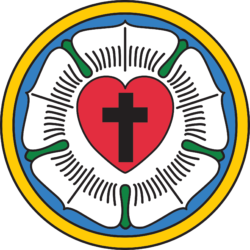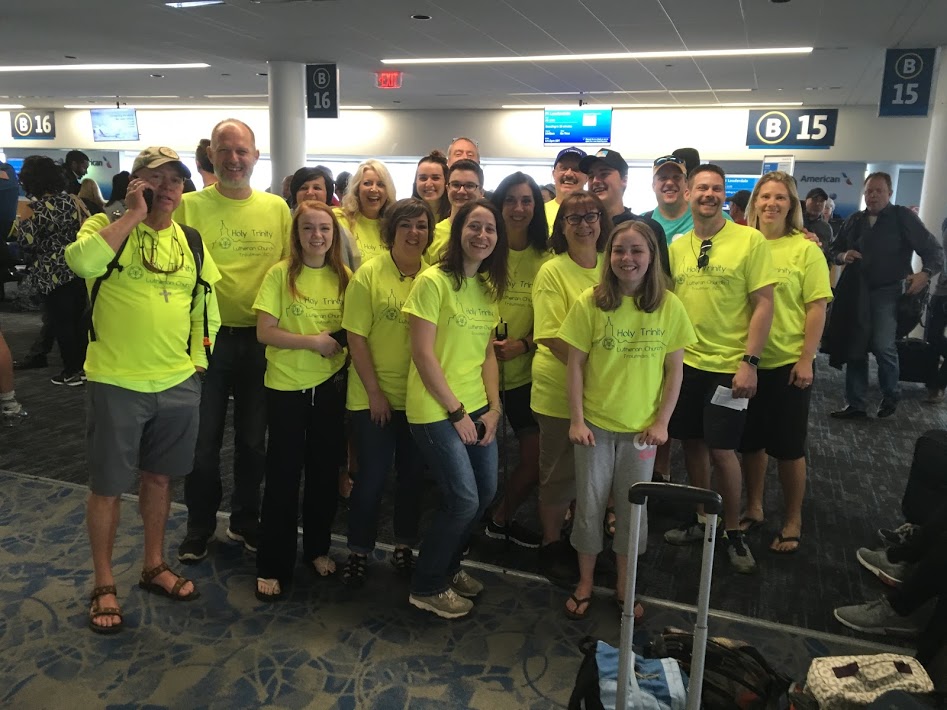“Therefore go and make disciples of all nations, baptizing them in the name of the Father and of the Son and of the Holy Spirit, and teaching them to obey everything I have commanded you. And surely I am with you always, to the very end of the age.” – Matthew 28:19-20
In the early morning of Monday, April 2nd, seventeen members from Holy Trinity Lutheran Church, in matching neon yellow t-shirts, drove to the Charlotte airport to fly on a mission trip to Haiti. Our food and supplies for the week were packed into checked bags. Each of us had our own carry-on bag for clothes and personal items. The first leg of our flight was from Charlotte, NC to Fort Lauderdale, FL. The second leg took us from Fort Lauderdale to Port-au-Prince, Haiti. A Haitian soccer team of 8-year-old boys, many of whom spoke fluent French, Haitian-Creole, and English were also aboard and made for an entertaining flight.
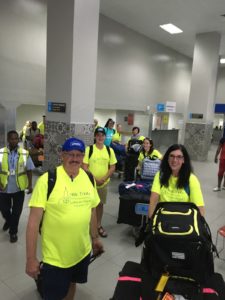 The airport in Port-au-Prince had a beautiful view of the mountains in the distance. We deboarded the airplane and went through customs. Jeff with Sundouloi Ministries (SMI Haiti) was waiting for us at the bottom of the escalator in baggage claim. He greeted us, collected our baggage claim receipts, and communicated the plan to get through the airport safely and successfully. All the bags were placed onto carts. The ladies pushed the carts while the men stood to the side to ensure no bags fell. We passed a group of TSA agents on our way out of the airport. Jeff made sure we were all together while communicating in Haitian Creole with the agents. There was a sense of urgency in Jeff’s voice that made the situation a little tense. Jeff had with him several Haitian men that worked for him to help us with our bags and to keep us safely together. Outside the airport, there were Haitians lined up on each side of the sidewalk speaking loudly and reaching out their hands. We stayed in a single file line pushing our luggage carts until we reached a school bus painted all white. This was our ride to the SMI Haiti mission house.
The airport in Port-au-Prince had a beautiful view of the mountains in the distance. We deboarded the airplane and went through customs. Jeff with Sundouloi Ministries (SMI Haiti) was waiting for us at the bottom of the escalator in baggage claim. He greeted us, collected our baggage claim receipts, and communicated the plan to get through the airport safely and successfully. All the bags were placed onto carts. The ladies pushed the carts while the men stood to the side to ensure no bags fell. We passed a group of TSA agents on our way out of the airport. Jeff made sure we were all together while communicating in Haitian Creole with the agents. There was a sense of urgency in Jeff’s voice that made the situation a little tense. Jeff had with him several Haitian men that worked for him to help us with our bags and to keep us safely together. Outside the airport, there were Haitians lined up on each side of the sidewalk speaking loudly and reaching out their hands. We stayed in a single file line pushing our luggage carts until we reached a school bus painted all white. This was our ride to the SMI Haiti mission house.
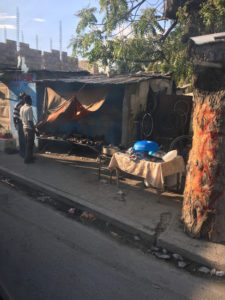 The drive from the airport to the mission house took approximately 90 minutes. The views during the drive made it immediately clear the depth of poverty in this country.
The drive from the airport to the mission house took approximately 90 minutes. The views during the drive made it immediately clear the depth of poverty in this country.
We saw men, women, and children walking or sitting on the side of the road. The buildings were made from poured concrete, cinder blocks, sheet metal, or woven leaves. Trash was everywhere. The other vehicles on the road passed aggressively while honking horns and flashing headlights. Haiti has no driver’s education classes and no yearly vehicle inspections. They drive with the understanding that the bigger vehicle has the right-of-way. There were buildings that had only a foundation surrounded by concrete rubble. For many families, it will take several generations to save up enough money to finish building their homes. Homes surrounded by concrete walls had razor wire or broken glass bottles at the top for an added security measure. The air smelt strong of burnt trash and diesel exhaust. It was common to see black smoke from random grass or trash fires.
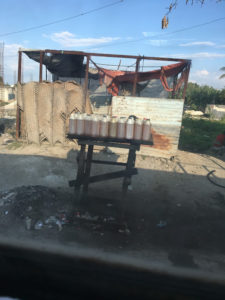 As we drove north out of Port-au-Prince, we passed a mass grave site where an estimated 250,000 bodies were buried after the devastating 2010 earthquake. There was also a newly constructed Olympics training center that seemed out of place considering the substantial poverty surrounding it. We passed through several villages on our way to the mission house. The Haitian children jumped and waved as they saw the bus approaching. The Haitian adults watched carefully and cautiously but would begin smiling and waving when we smiled and waved to them. Wandering goats, dogs, and chickens were everywhere. A couple families owned a horse or a cow, all of which were alarmingly thin. The animals in Haiti do not visit a veterinarian and many of them (the dogs especially) looked quite ill.
As we drove north out of Port-au-Prince, we passed a mass grave site where an estimated 250,000 bodies were buried after the devastating 2010 earthquake. There was also a newly constructed Olympics training center that seemed out of place considering the substantial poverty surrounding it. We passed through several villages on our way to the mission house. The Haitian children jumped and waved as they saw the bus approaching. The Haitian adults watched carefully and cautiously but would begin smiling and waving when we smiled and waved to them. Wandering goats, dogs, and chickens were everywhere. A couple families owned a horse or a cow, all of which were alarmingly thin. The animals in Haiti do not visit a veterinarian and many of them (the dogs especially) looked quite ill.
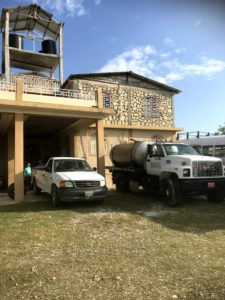 The mission house is in the village of Dasse. It is surrounded by a tall concrete stone wall with razor wire. Several children were playing in the open yard next to the house when we arrived. The house has two stories with a large kitchen, open patio, and multiple bedrooms. The HTLC women slept in the two bedrooms and the HTLC men slept in the open balcony. Upon arrival, we claimed our bed, brought our food to the kitchen, and separated our supplies for the week. Amy and Macey were our cooks for the week (a mother and daughter from Cleveland, TN). They had arrived the prior day and had supper waiting for us. After dinner we gathered on the patio for an orientation. Jeff went through a lot of information about the week ahead. He explained that Americans want to see immediate progress and finished tasks as a sign of a job well done. He warned us that might not happen this week and we should keep our expectations to a reasonable level. He asked us to let God lead us; to not be tied to specific plans and goals but instead let God make our plans. After a group prayer and Christian music, some of us discovered the cold showers while others were off to bed.
The mission house is in the village of Dasse. It is surrounded by a tall concrete stone wall with razor wire. Several children were playing in the open yard next to the house when we arrived. The house has two stories with a large kitchen, open patio, and multiple bedrooms. The HTLC women slept in the two bedrooms and the HTLC men slept in the open balcony. Upon arrival, we claimed our bed, brought our food to the kitchen, and separated our supplies for the week. Amy and Macey were our cooks for the week (a mother and daughter from Cleveland, TN). They had arrived the prior day and had supper waiting for us. After dinner we gathered on the patio for an orientation. Jeff went through a lot of information about the week ahead. He explained that Americans want to see immediate progress and finished tasks as a sign of a job well done. He warned us that might not happen this week and we should keep our expectations to a reasonable level. He asked us to let God lead us; to not be tied to specific plans and goals but instead let God make our plans. After a group prayer and Christian music, some of us discovered the cold showers while others were off to bed.
Tuesday morning, the group awoke to an eager rooster’s crow. The rooster began crowing around 2:30 AM and didn’t seem to ever quit (both day and night). We slowly gathered on the patio. Jeff talked about our group and specifically the personalities within our group. He explained that Haiti may cause the extroverts to be even more extroverted while the introverts may feel even more introverted.
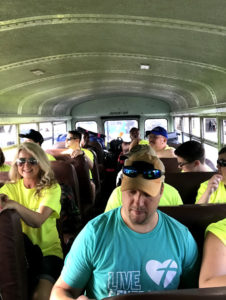 Those with naturally higher anxiety may struggle with even more anxiety. With that information, we prayed for one of our group members whose anxiety was heightened. After the prayer, we began to formulate our plan for the day. After breakfast, we divided into two groups. One group began planning a vacation Bible school for the children in the village. Another group began packaging 1,000 lbs of rice and beans into family-sized portions to pass out later in the day. After both groups were finished, we came together to take a walk down to the ocean.
Those with naturally higher anxiety may struggle with even more anxiety. With that information, we prayed for one of our group members whose anxiety was heightened. After the prayer, we began to formulate our plan for the day. After breakfast, we divided into two groups. One group began planning a vacation Bible school for the children in the village. Another group began packaging 1,000 lbs of rice and beans into family-sized portions to pass out later in the day. After both groups were finished, we came together to take a walk down to the ocean.
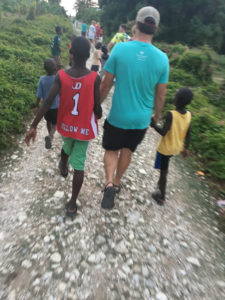 Once we left the mission house, the village children ran to us and grabbed our hands. We exchanged smiles and walked hand in hand to the water. We passed families and caught our first up-close glimpse of the living situations. Trash lined the roads. The shacks appeared to have one or two rooms. Woven leaf walls provided a little more privacy and shade from the sun. An elderly man was sitting in a wheelchair. The wheelchair had no support for his arms. The back was barely holding on and the tires were down to the rims. (Later in the week, a couple HTLC men made new arm rests for the wheelchair.) Down at the beach, the view of the mountains was beautiful, but like everywhere else it was littered with trash. We gathered around a fishing boat surrounded by mango trees to hear a story from Charlie, one of the Haitians that has worked with SMI for over 20 years.
Once we left the mission house, the village children ran to us and grabbed our hands. We exchanged smiles and walked hand in hand to the water. We passed families and caught our first up-close glimpse of the living situations. Trash lined the roads. The shacks appeared to have one or two rooms. Woven leaf walls provided a little more privacy and shade from the sun. An elderly man was sitting in a wheelchair. The wheelchair had no support for his arms. The back was barely holding on and the tires were down to the rims. (Later in the week, a couple HTLC men made new arm rests for the wheelchair.) Down at the beach, the view of the mountains was beautiful, but like everywhere else it was littered with trash. We gathered around a fishing boat surrounded by mango trees to hear a story from Charlie, one of the Haitians that has worked with SMI for over 20 years.
 Charlie told his emotional story about his attempt to flee Haiti when he was in his 20’s (approx. 40 years ago). There was a small boat leaving Haiti and he snuck aboard. Once on the water, the voodoo rituals began and it became clear to everyone else on the boat that Charlie was a Christian. When he was confronted, he stood firm in his convictions and told the boat of voodoo worshipers that he was a Christian, knowing this would would mean almost certain death. They threw Charlie overboard into shark infested waters but he managed to take another man with him into the water. While the men on the boat tried to rescue the other man, Charlie grabbed onto him. He made it back in the boat. A woman asked that his life be spared and said if he was meant to die, he would have died. They allowed him to remain on the boat but blamed him for every bad thing that happened on their journey. Once they landed in Cuba, he worked in a camp. While in Cuba, Charlie met Fidel Castro. Eventually, Charlie made it on another boat headed for the USA. When that boat lost its way, and ended up in Panama waters, Charlie was again blamed for their misfortune. The group eventually made it to USA waters outside of Key West. Charlie never denied Christ as his Lord, even when it meant his own potential death.
Charlie told his emotional story about his attempt to flee Haiti when he was in his 20’s (approx. 40 years ago). There was a small boat leaving Haiti and he snuck aboard. Once on the water, the voodoo rituals began and it became clear to everyone else on the boat that Charlie was a Christian. When he was confronted, he stood firm in his convictions and told the boat of voodoo worshipers that he was a Christian, knowing this would would mean almost certain death. They threw Charlie overboard into shark infested waters but he managed to take another man with him into the water. While the men on the boat tried to rescue the other man, Charlie grabbed onto him. He made it back in the boat. A woman asked that his life be spared and said if he was meant to die, he would have died. They allowed him to remain on the boat but blamed him for every bad thing that happened on their journey. Once they landed in Cuba, he worked in a camp. While in Cuba, Charlie met Fidel Castro. Eventually, Charlie made it on another boat headed for the USA. When that boat lost its way, and ended up in Panama waters, Charlie was again blamed for their misfortune. The group eventually made it to USA waters outside of Key West. Charlie never denied Christ as his Lord, even when it meant his own potential death.
 After walking back from the ocean, we walked into Dasse to a school that was built by SMI Haiti. The school is for kindergarten through sixth grade children. It is one large room with multiple classes in session at once. All the children were in matching uniforms. The teachers also had their own uniforms. For $365, a child can attend school for the entire year. The children are required to keep passing grades and good attendance. They also receive a meal during the day. Half of our HTLC group was tasked with weed-eating, moving rocks, and trash pick-up in the school yard while the other half held VBS for the children. The Haitians worked right alongside us. Some of the Haitian children chose to grab a rake and work in the hot sun instead of attend VBS. After VBS was finished, a few of us painted an initial coat of paint on the newly hung drywall that made an office for the school. The village has one water source for all its needs (cooking, laundry, bathing, etc.). The water source is a culvert diverted from a river. This was also the only source of water the painters had to rinse their paint brushes, turning the water bright white.
After walking back from the ocean, we walked into Dasse to a school that was built by SMI Haiti. The school is for kindergarten through sixth grade children. It is one large room with multiple classes in session at once. All the children were in matching uniforms. The teachers also had their own uniforms. For $365, a child can attend school for the entire year. The children are required to keep passing grades and good attendance. They also receive a meal during the day. Half of our HTLC group was tasked with weed-eating, moving rocks, and trash pick-up in the school yard while the other half held VBS for the children. The Haitians worked right alongside us. Some of the Haitian children chose to grab a rake and work in the hot sun instead of attend VBS. After VBS was finished, a few of us painted an initial coat of paint on the newly hung drywall that made an office for the school. The village has one water source for all its needs (cooking, laundry, bathing, etc.). The water source is a culvert diverted from a river. This was also the only source of water the painters had to rinse their paint brushes, turning the water bright white.
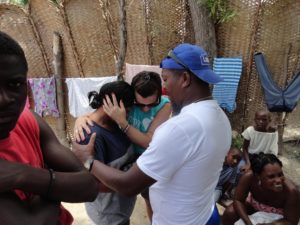 On the walk back to the mission house, each of us had at least one or two Haitian children holding our hands the entire way. Some of the children asked for our name and told us their names in return. Other children were happy to simply share a smile and leisurely stroll. After dinner we walked back into the village to pass out rice and beans. We had a translator with us in order to introduce ourselves, communicate with the family, and pray for any specific needs the families requested. Most of the time the request was for illnesses they were battling but some of the Haitians asked we pray in general as they were struggling in every aspect of life. The group also handed out separate bags of necessities to some of the women that included toothbrushes, toothpaste, nail kits, feminine products, etc. That evening at circle time the group reflected on the day and praised God in music and prayer.
On the walk back to the mission house, each of us had at least one or two Haitian children holding our hands the entire way. Some of the children asked for our name and told us their names in return. Other children were happy to simply share a smile and leisurely stroll. After dinner we walked back into the village to pass out rice and beans. We had a translator with us in order to introduce ourselves, communicate with the family, and pray for any specific needs the families requested. Most of the time the request was for illnesses they were battling but some of the Haitians asked we pray in general as they were struggling in every aspect of life. The group also handed out separate bags of necessities to some of the women that included toothbrushes, toothpaste, nail kits, feminine products, etc. That evening at circle time the group reflected on the day and praised God in music and prayer.
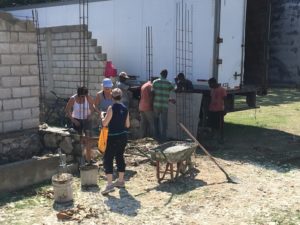 Wednesday morning, we drove to another village called Kamitan where SMI has projects that include a church building, health and education center, and a quadruplex apartment (each apartment contains one room for a bed, a room for the kitchen, and a small entryway – no running water or toilets). The Haitian children in Kamitan flocked to us with outstretched arms. We brought them soccer balls and jump ropes. We split into work groups where some of us painted the apartment, some of us hand-mixed concrete for the construction of a wall, and some of us played with the Haitian children. God placed each of us where he saw us fitting the best and where we were most needed. The village was surrounded by plantain and mango trees but otherwise looked the same as Dasse with small shacks and not much else. There was trash littered everywhere with an especially tall pile down by the ocean. On our drive back to the mission house we passed a man breaking a large stone into smaller pieces by hand to sell as gravel. He had been there all day.
Wednesday morning, we drove to another village called Kamitan where SMI has projects that include a church building, health and education center, and a quadruplex apartment (each apartment contains one room for a bed, a room for the kitchen, and a small entryway – no running water or toilets). The Haitian children in Kamitan flocked to us with outstretched arms. We brought them soccer balls and jump ropes. We split into work groups where some of us painted the apartment, some of us hand-mixed concrete for the construction of a wall, and some of us played with the Haitian children. God placed each of us where he saw us fitting the best and where we were most needed. The village was surrounded by plantain and mango trees but otherwise looked the same as Dasse with small shacks and not much else. There was trash littered everywhere with an especially tall pile down by the ocean. On our drive back to the mission house we passed a man breaking a large stone into smaller pieces by hand to sell as gravel. He had been there all day.
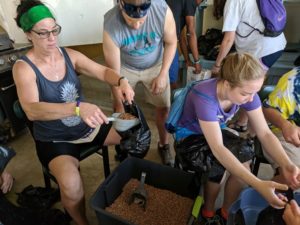 After lunch we drove to the city of Arcahaie to a market. Jeff had a list of supplies to buy for the Haitian family moving into the new apartment in Kamitan. Jeff warned the group that we must stick together. The market was very busy and it would be easy to get separated. We entered the building and walked straight upstairs were it was a little less chaotic. We were able to take pictures on the second story. A couple people from our group went with SMI-Charlie to buy the supplies needed. The rest of us walked through the meat market on our way back to the bus. The stench of raw fish and meats was very thick in the air. Most of the meats were covered in flies. We left Arcahaie and took the bus back to Kamitan to pass out more rice and beans to the local families. We visited with many families and prayed for them with the help of the SMI translators. The Haitians were very appreciative but there was also pain in their eyes that showed us their struggle. We stopped at one more SMI church on our way back to the mission house. After dinner we gathered for group time on the patio and reflected on the day. Testimonies were shared by some and we discussed all the good ways God was guiding and changing us on this journey. We talked about how God takes our burdens and replaces them with strengths when we rely on him. Jeff talked about how Satan is a little more out-in-the-open here verses a little better hidden in the USA. This is clear by the voodoo temple located directly west of the mission house.
After lunch we drove to the city of Arcahaie to a market. Jeff had a list of supplies to buy for the Haitian family moving into the new apartment in Kamitan. Jeff warned the group that we must stick together. The market was very busy and it would be easy to get separated. We entered the building and walked straight upstairs were it was a little less chaotic. We were able to take pictures on the second story. A couple people from our group went with SMI-Charlie to buy the supplies needed. The rest of us walked through the meat market on our way back to the bus. The stench of raw fish and meats was very thick in the air. Most of the meats were covered in flies. We left Arcahaie and took the bus back to Kamitan to pass out more rice and beans to the local families. We visited with many families and prayed for them with the help of the SMI translators. The Haitians were very appreciative but there was also pain in their eyes that showed us their struggle. We stopped at one more SMI church on our way back to the mission house. After dinner we gathered for group time on the patio and reflected on the day. Testimonies were shared by some and we discussed all the good ways God was guiding and changing us on this journey. We talked about how God takes our burdens and replaces them with strengths when we rely on him. Jeff talked about how Satan is a little more out-in-the-open here verses a little better hidden in the USA. This is clear by the voodoo temple located directly west of the mission house.
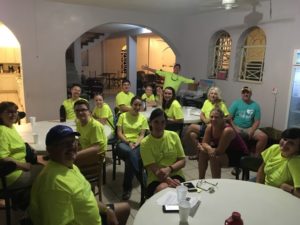 Thursday morning we drove to the Canaan orphanage. There is a large church next to the orphanage where the group met the children. We played guitar and mandolin, sang songs, played musical chairs, ran three-legged-races, played Ring Around the Rosy, and gave the children coloring books and crayons. We served hot dogs and juice to the children. We sang Jesus Loves Me to the children in English and the children sang us a song in Haitian Creole. We brought many pairs of underwear and socks for the children. The church was a dark and dreary gray/teal color on the inside. Pastor Louade is the pastor of the church and explained how he had wanted to paint the church a few months prior but he did not have the resources. That made it clear to the group what our Thursday afternoon project needed to be. A group of us returned to the church after lunch to paint it white. We applied two coats of paint and it made a huge difference. After painting, a few of us toured the orphanage. There were only two rooms (one for boys, one for girls). The girls and boys had bunk beds where they slept 2-3 per bed. There were no toys or anything else that you would typically see to let you know children lived there. What we did notice was a phrase painted above the doorways. “Jezi Renmemw” which translates to “Jesus Lives.”
Thursday morning we drove to the Canaan orphanage. There is a large church next to the orphanage where the group met the children. We played guitar and mandolin, sang songs, played musical chairs, ran three-legged-races, played Ring Around the Rosy, and gave the children coloring books and crayons. We served hot dogs and juice to the children. We sang Jesus Loves Me to the children in English and the children sang us a song in Haitian Creole. We brought many pairs of underwear and socks for the children. The church was a dark and dreary gray/teal color on the inside. Pastor Louade is the pastor of the church and explained how he had wanted to paint the church a few months prior but he did not have the resources. That made it clear to the group what our Thursday afternoon project needed to be. A group of us returned to the church after lunch to paint it white. We applied two coats of paint and it made a huge difference. After painting, a few of us toured the orphanage. There were only two rooms (one for boys, one for girls). The girls and boys had bunk beds where they slept 2-3 per bed. There were no toys or anything else that you would typically see to let you know children lived there. What we did notice was a phrase painted above the doorways. “Jezi Renmemw” which translates to “Jesus Lives.”
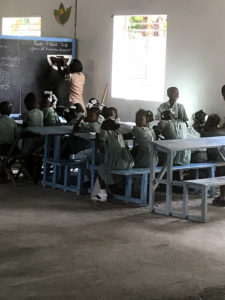 While half of our group was painting the church, the rest of us went to the Guitton school to host a gathering with the local young women and teens. We taught the women table manners and shared food. Later that evening, we hosted a hot dog party at the mission house for the local children in Dasse. We served hot dogs and Kool-Aid and played Finding Nemo on a projector against the side of the mission house. The movie was in English instead of Haitian Creole but the children loved it anyway. During the hot dog party, we met in the kitchen to hear a story from Pastor Jean Marie.
While half of our group was painting the church, the rest of us went to the Guitton school to host a gathering with the local young women and teens. We taught the women table manners and shared food. Later that evening, we hosted a hot dog party at the mission house for the local children in Dasse. We served hot dogs and Kool-Aid and played Finding Nemo on a projector against the side of the mission house. The movie was in English instead of Haitian Creole but the children loved it anyway. During the hot dog party, we met in the kitchen to hear a story from Pastor Jean Marie.
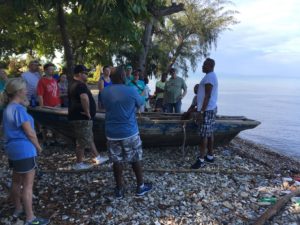 Pastor Jean Marie had become very ill. His family practiced voodoo and decided to use him as a sacrifice in a ritual. The voodoo witch doctor placed him in a coffin four different times but he would not die. He was becoming more and more ill. The witch doctor performing the rituals finally drove him to a local hospital but instead of going into the hospital they gathered under a group of tall trees next to the hospital. When his family came back later to claim his body they found him to have bugs crawling in his eyes, nose, and ears but when they felt his chest they realized he was still alive. He had lock-jaw so they pried open his mouth with a spoon and gave him water. He began to improve in the hospital. In Port-au-Prince a minister began teaching him about God and the Bible. That was the beginning of his journey to becoming a pastor. A few years later he met a couple with small children who were about to board a boat to leave Haiti. He felt the Holy Spirit urging him to keep the children. He convinced the couple to leave the children and send for them later. The couple never made it. Their boat sank. Pastor Jean Marie raised the children himself.
Pastor Jean Marie had become very ill. His family practiced voodoo and decided to use him as a sacrifice in a ritual. The voodoo witch doctor placed him in a coffin four different times but he would not die. He was becoming more and more ill. The witch doctor performing the rituals finally drove him to a local hospital but instead of going into the hospital they gathered under a group of tall trees next to the hospital. When his family came back later to claim his body they found him to have bugs crawling in his eyes, nose, and ears but when they felt his chest they realized he was still alive. He had lock-jaw so they pried open his mouth with a spoon and gave him water. He began to improve in the hospital. In Port-au-Prince a minister began teaching him about God and the Bible. That was the beginning of his journey to becoming a pastor. A few years later he met a couple with small children who were about to board a boat to leave Haiti. He felt the Holy Spirit urging him to keep the children. He convinced the couple to leave the children and send for them later. The couple never made it. Their boat sank. Pastor Jean Marie raised the children himself.
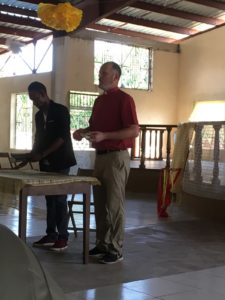 During that evening group time, we heard from one of the Haitian SMI men working with Jeff. He explained the struggles of being a man in his 20’s following God when all his friends do not attend church. We prayed over him and asked God to continue to be a strong presence in his life.
During that evening group time, we heard from one of the Haitian SMI men working with Jeff. He explained the struggles of being a man in his 20’s following God when all his friends do not attend church. We prayed over him and asked God to continue to be a strong presence in his life.
On Friday morning, we met for circle time where it was decided we would take our remaining funds that were to be used to visit the beach and instead purchase more rice and beans to distribute to even more families. We purchased another 1,000 lbs of rice and beans and spent the morning separating it into family sized portions. We drove to Nowwash to distribute the meals. We met with the local Haitian families, introduced ourselves, and prayed for their needs. Some of the people we met were not yet Christians and we knew there was a good chance they were practicing voodoo. The Haitian children were happy to see us and hold our hands. We passed out candy and beaded cross bracelets to the children and basic supplies to the women.
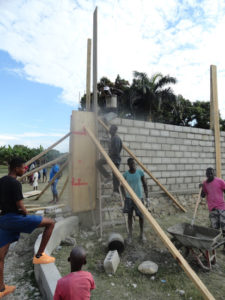 After all meals were distributed we drove to Cipirus to see the large church and school built by SMI. Pastor Punt went to this church earlier in the week to deliver a sermon to hundreds of Haitians. After touring the buildings, we returned to Kamitan, where we brought the remaining soccer balls and jump ropes. On the drive to Kamitan we took a shortcut through a dried-up riverbed. We noticed even more trash dumped there and were told the Haitians drop off their trash in the river because when there is a torrential downpour, the water off the mountain takes all their trash out to the ocean. We were able to spend good quality time with the children and got the newly painted apartment set up for the family moving into it. A few of us helped to mix more concrete and move the concrete by bucket or wheel barrow to the wall that was being constructed around the apartments. The Haitians take each bucket full of concrete individually and pour it into the wall by hand. This gave us a new appreciation for our concrete trucks. This wall was the wall HTLC funded.
After all meals were distributed we drove to Cipirus to see the large church and school built by SMI. Pastor Punt went to this church earlier in the week to deliver a sermon to hundreds of Haitians. After touring the buildings, we returned to Kamitan, where we brought the remaining soccer balls and jump ropes. On the drive to Kamitan we took a shortcut through a dried-up riverbed. We noticed even more trash dumped there and were told the Haitians drop off their trash in the river because when there is a torrential downpour, the water off the mountain takes all their trash out to the ocean. We were able to spend good quality time with the children and got the newly painted apartment set up for the family moving into it. A few of us helped to mix more concrete and move the concrete by bucket or wheel barrow to the wall that was being constructed around the apartments. The Haitians take each bucket full of concrete individually and pour it into the wall by hand. This gave us a new appreciation for our concrete trucks. This wall was the wall HTLC funded.
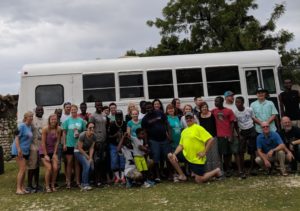 Our last dinner on Friday was Haitian themed with chicken, rice and beans, a beet salad, plantains, and mangos. Group time on the patio was spent reflecting on the week and the good that was accomplished through God. The next morning was spent reflecting and praising God for the opportunities he presented to us during the week. We shared our experiences and how we thought this might change us and others in our lives back home. We also thought about ways we would be able to continue to assist the Haitian people while we are back in the USA. We packed our bags and said our goodbyes to our beloved Haitian SMI staff as well as our cooks Amy and Macey. Then we boarded the white school bus that took us back to the Port-au-Prince airport.
Our last dinner on Friday was Haitian themed with chicken, rice and beans, a beet salad, plantains, and mangos. Group time on the patio was spent reflecting on the week and the good that was accomplished through God. The next morning was spent reflecting and praising God for the opportunities he presented to us during the week. We shared our experiences and how we thought this might change us and others in our lives back home. We also thought about ways we would be able to continue to assist the Haitian people while we are back in the USA. We packed our bags and said our goodbyes to our beloved Haitian SMI staff as well as our cooks Amy and Macey. Then we boarded the white school bus that took us back to the Port-au-Prince airport.
Pastor Dieter Punt serves Holy Trinity Lutheran Church in Troutman, North Carolina. To learn more about the NALC’s Recognized Ministry SMI Haiti, please visit: The Great Commission Society.

